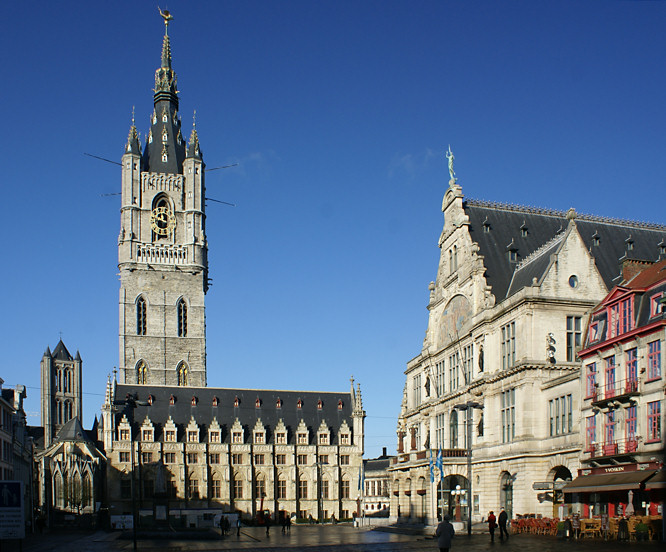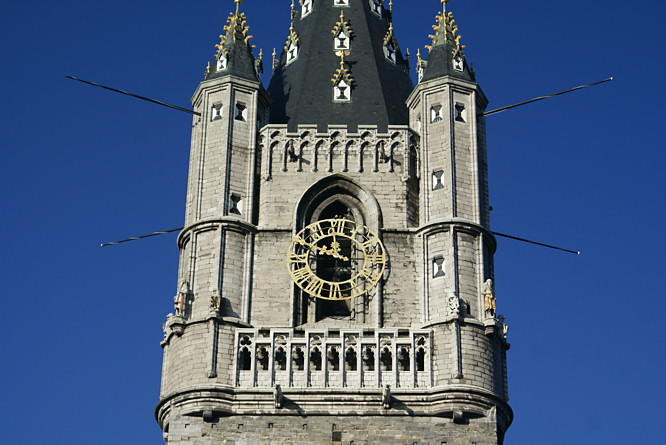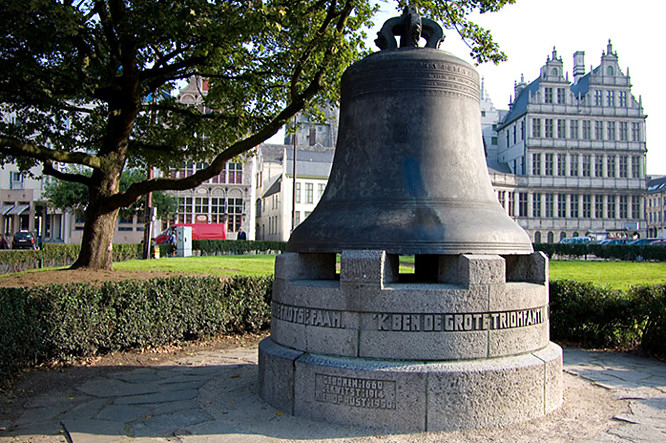Ghent's Lakenhalle Cloth Hall and Belfry
The tall Belfry tower stands in between the two cathedrals in the centre of the city. It is one of the three famous towers of Ghent. Against the belfry tower stands the old Lakenhalle cloth hall of Ghent, In the Middle Ages Ghent was one of the most important places for the trade of wool and cloth.

Wool was produced locally and imported from Scotland and England to supply the local weavers. This trade made Ghent rich and its merchants prosperous. Every cloth produced in Ghent and a mile outside Ghent had to be brought ot the Lakenhalle by law. The textile was inspected and measured by three Halleheren, inspectors of the hall, before it could be sold
The construction of the hall started in 1425 but in 1441, with only 7 of the 11 planned bays completed, the building works were stopped. At that moment the cloth trade was already past its peak and did not require the extra capacity. The incomplete cloth hall served other purposes. Since 1613, the municipal fencing-school and the militia guild of Saint-Michael were installed on the first and second floor. From 1742 to 1902, the crypt served as the town jail. The remaining 4 bays were only added in 1903.

The tourist office is now situated on the ground floor. Compared with other cities in Europe it is a very poor. There is not much information available and it is rather drab. The only interesting thing in the Tourist office is some fine stained glass windows. The first floor can be rented for private functions and public events. On the second floor, the Museum of the Guild of Saint Michael (Sint-Michielsguild) has exhibits on the rich tradition of the Ghent Saint Michaels' Guild. The attic is still used as a training room for the fencing-school.
The Lakenhalle Belfry Tower
The Ghent Belfry tower or Gent Belfort is 91 metres (298 feet ) tall. It is another impressive landmark on the city's skyline. You can visit the tower and climb to the top. The Belfort is the best place to get a view over this magnificent historic city. You can walk to the top, but if you have a problem climbing lots of stairs or are just lazy like me, you can also use a combination of stairs and elevators. It has 6 floors. The visit starts on the bottom floor in a small secret room where you can see four stone guards.
You then climb up some stairs to a small museum. Here you will find one of the original copper dragons from the top of the Ghent Belfry tower. It is from this level that you can take the elevator to the next floor to see the bells. There is a video on bell making to watch. Another elevator will take you up to see the carillion drum and clock mechanism. The present clock dates from 1912 and has to be wound up daily. On the fifth floor you can enjoy breathtaking views over the roof tops of old historic Ghent. It is open from 10am to 12 noon and 2pm to 5.30pm. It cost about 5 Euros.

The carillon set of bells, hung in the bell tower are part of the Flemish tradition of bell music. The bells ring out regularly and their sound is one of my main memories of Gent. Belforts, or belfries, in medieval towns such as Gent were constructed as watch towers over the city. They were used for storing important town documents. The carillion bells in the tower announced important events such as enemies approaching or executions. Every Friday & Sunday at noon, 54 bells chime in a concert that lasts about 10 minutes
Ghent's Belfort at one time had a famous giant bell named 'Roeland' but it was destroyed in 1540 by Charles V to punish the rebellious residents, 37 of the 54 bells in the present day carillion are Roeland's offspring as the metal in the large beel was used to make them. In 1914, one of these, the 'Triomfant bell', burst while being electrically tested, and can now be seen on the ground in the square next to the tower.
Travel books

